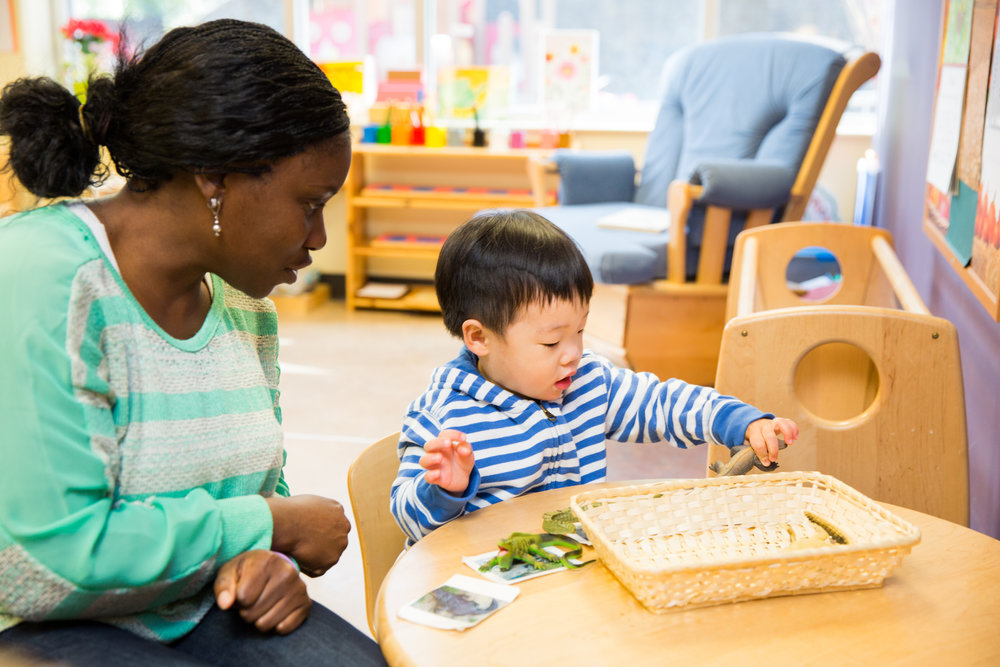
by Anne Prowant
Mahatma Gandhi once said, “If we are to teach real peace in this world… we shall have to begin with the children.” Maria Montessori, a great admirer and personal friend of Gandhi, certainly agreed. Montessori asserted throughout her life that children were the redeeming hope of civilization, and that education was the method through which world peace would spread. If children were allowed to develop according to their own inner guides, Montessori believed, their tendency would be to exhibit joy, understanding and acceptance, and would lead to a more peaceful society.

Because peace education was such an essential part of Maria Montessori’s pedagogy, every Montessori classroom has a peace curriculum that can be seen and felt in each subject area, and throughout the classroom as a whole. In fact, the peace curriculum is often called the invisible curriculum- there’s no one specific place that you can find it, because it permeates every inch of the classroom. In order to establish this aura of peace, an atmosphere of respect is cultivated among all the members of the community, and this is modeled first and foremost by the adults. Respectful communication and acceptance of others, in fact, are the first ways in which the teachers model peace to the children. As a result, children can feel free to be themselves without fear of ridicule, and without feeling the need to ridicule others.
If a conflict does arise, the children are able to resolve it themselves by using the peace rose. The peace rose is a common tool used in Montessori classrooms to teach children to respectfully work out their differences. Whoever is holding the peace rose is allowed to speak, and the children take turns passing the rose back and forth, explaining their feelings to each other. This way, each child feels heard. While the peace rose is initially presented and facilitated by the teacher, children are eventually able to take out the peace rose all on their own. By giving children tools to solve conflicts peacefully, Montessori schools are equipping them with tools that they can take with them to live a more peaceful life now and in the future.
Grace and courtesy is another important way that peace curriculum is found in the classroom. Grace and courtesy are lessons that teach basic manners, and it is through them that the child learns to be empathetic, self-aware and responsible. Things like waiting your turn, pushing in your chair, speaking in a quiet voice and even blowing your nose are considered grace and courtesy lessons. The teachers model these skills, and encourage the children to practice them as well. As a result, children develop the confidence to function independently in the classroom, as well as in life.
Of course, situations often occur in which a behavior needs to be addressed by the teacher, called “redirection.”. When a child needs to be redirected, it is done in a way that is respectful of his feelings and preserves his dignity. The teacher pulls aside the child, speaks to him in a quiet voice, and listens to what he has to say. She acknowledges his feelings, and then encourages the child to show kindness and compassion to the person he has hurt. The child who has been hurt is given the opportunity to voice their feelings, and explain how reparations can be made (a hug, saying “I’m sorry”, etc). Each child, in the end, feels respected, heard, and cared for, and the problem is solved.

An activity called the silence game is another important tool that Montessorians use in their peace curriculum. The children, either as a group or individually, are often called to be as quiet as possible, listening to the sound of their breathing, or the noises outside the window, or simply to call attention to their own thoughts. In her book, The Secret of Childhood, Montessori described the first silence game. “One day I had the idea of using silence to test the children’s keenness of hearing, so I thought of calling them by name in a low whisper…This exercise in patient waiting demanded a patience that I thought impossible.” Making silence requires great self-control, and the children take a huge amount of pride and joy in it. It is often surprising to outsiders to see very young children having the self-control to sit quietly for three or five minutes at a time, and the result is a feeling of achievement and community.
Having seen the world torn apart by war twice in her lifetime, Maria Montessori understood the importance of developing a spirit of acceptance within children if we were ever to hope for a peaceful society. In her work, Education and Peace, she said, “Establishing lasting peace is the work of education; all politics can do is keep us out of war.” Peace education is an essential component of a Montessori classroom, and since the classroom is a microcosm of the larger world the lessons that children learn there will serve them well throughout the rest of their lives. We can only hope that in the future they will continue to draw upon what they learned during their days in a Montessori environment and meet others with compassion, kindness and understanding, creating a more peaceful world along the way.

